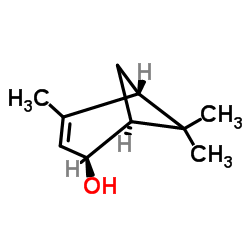(S)-cis-Verbenol

(S)-cis-Verbenol structure
|
Common Name | (S)-cis-Verbenol | ||
|---|---|---|---|---|
| CAS Number | 18881-04-4 | Molecular Weight | 152.233 | |
| Density | 1.0±0.1 g/cm3 | Boiling Point | 214.9±9.0 °C at 760 mmHg | |
| Molecular Formula | C10H16O | Melting Point | 62-65ºC(lit.) | |
| MSDS | USA | Flash Point | 84.5±11.0 °C | |
| Symbol |

GHS07 |
Signal Word | Warning | |
|
Electrophysiological and behavioral responses of the bark beetle Dendroctonus rhizophagus to volatiles from host pines and conspecifics.
J. Chem. Ecol. 38(5) , 512-24, (2012) The bark beetle Dendroctonus rhizophagus is endemic to northwestern Mexico where it kills immature pines < 3 m tall. We report the first investigation of the chemical ecology of this pest of forest regeneration. We used GC-EAD to assess olfactory sensitivity ... |
|
|
Chemical composition and antioxidant activity of the essential oil of Juniperus phoenicea L. berries.
Nat. Prod. Res. 25(18) , 1695-706, (2011) This study is designed to examine the chemical composition and antioxidant activity of the essential oil of Juniperus phoenicea L. ripe and unripe berries. GC and GC/MS analyses resulted in the detection of 42 components representing approximately 96.50-99.57... |
|
|
Composition and antifungal activity of the essential oil from the rhizome and roots of Ferula hermonis.
Phytochemistry 72(11-12) , 1406-13, (2011) The analysis of the essential oil from rhizome and roots of Ferula hermonis Boiss. (Apiaceae) by GC-FID, GC-MS and ¹³C NMR allowed the identification of 79 constituents, more than 90% of the oil, the major one being α-pinene (43.3%), followed by α-bisabolol (... |
|
|
Gut-Associated Bacteria of Dendroctonus valens and their Involvement in Verbenone Production.
Microb. Ecol. 70 , 1012-23, (2015) Bark beetles are the most important mortality agent in coniferous forests, and pheromones play important roles in their management. Dendroctonus valens LeConte was introduced from North America to China and has killed millions of healthy pines there. Trapping... |
|
|
Formation of trans-verbenol and verbenone from alpha-pinene catalysed by immobilised Picea abies cells.
Biosci. Biotechnol. Biochem. 69(2) , 321-5, (2005) Both enantiomers and the racemate of alpha-pinene were transformed by Picea abies cells immobilised on alginate. The main products were cis- and trans-verbenol, the later being further transformed to verbenone. The enantiomeric purity of each product more or ... |
|
|
Dose-dependent response and preliminary observations on attraction range of Ips typographus to pheromones at low release rates.
J. Chem. Ecol. 27(12) , 2425-35, (2001) Responses of the European spruce bark beetle, 1. typographus (Coleoptera: Scolytidae), to low release-rate pheromones were investigated in two experiments in a spruce forest at Wellin, southern Belgium. Dose-response of the beetle was first examined in a trap... |
|
|
Aggregation pheromone of the Qinghai spruce bark beetle, Ips nitidus eggers.
J. Chem. Ecol. 35(5) , 610-7, (2009) Volatiles from hindgut extracts of males of the Qinghai spruce bark beetle, Ips nitidus, from different attack phases (phase 1: unpaired males and phases 2-4: males joined with one to three females) and hindgut extracts of mated females were analyzed by gas c... |
|
|
Strain improvement of Aspergillus sp. and Penicillium sp. by induced mutation for biotransformation of alpha-pinene to verbenol.
Biotechnol. Bioeng. 63(2) , 249-52, (1999) Variants of Aspergillus sp. and Penicillium sp. obtained after treatment with colchicine, ethyl methanesulphonate (EMS), or ultraviolet (UV) irradiation indicated varying levels of significant increases in their efficiency to transform alpha-pinene to verbeno... |
|
|
High individual variation in pheromone production by tree-killing bark beetles (Coleoptera: Curculionidae: Scolytinae).
Naturwissenschaften 95(1) , 33-44, (2008) Aggregation via pheromone signalling is essential for tree-killing bark beetles to overcome tree defenses and reproduce within hosts. Pheromone production is a trait that is linked to fitness, so high individual variation is paradoxical. One explanation is th... |
|
|
Monoterpene and wood dust exposures: work-related symptoms among Finnish sawmill workers.
Am. J. Ind. Med. 41(1) , 38-53, (2002) Monoterpenes and wood dust are released into the work environment during sawing of fresh wood. Symptoms related to exposure to monoterpenes and wood dust include irritation of the eyes, mucous membrane, and skin.We studied 22 sawhouse workers who process pine... |